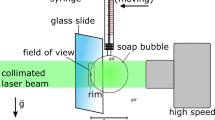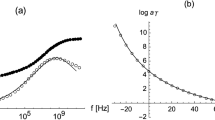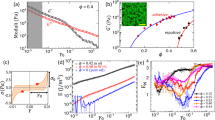Abstract
Indentation hardness tests are now widely used to measure the mechanical properties of solid surfaces1–3. Recent developments of this technique4,5 permit the analysis of the outermost 10 nm of materials. Experimental and theoretical questions arise regarding the physical and mechanical processes involved in such small indentations. We describe here an indentation experiment on a microscopic scale, using soap bubbles blown onto a water surface. Bubble rafts provide a simple two-dimensional model for indentation behaviour; as for other materials, their behaviour is governed by two principal attraction–repulsion forces6, and by geometrical constraints. A crystalline two-dimensional lattice is obtained by using bubbles of uniform size7–9, whereas bubbles of two sizes give an amorphous structure10,11. Indentation can be represented by the contact between a triangular crystalline raft and a rectangular crystalline raft bordered by an amorphous layer. The flow of the materials, which is dependent on both adhesion and the force between the two rafts, can be analysed during the experiment.
This is a preview of subscription content, access via your institution
Access options
Subscribe to this journal
Receive 51 print issues and online access
$199.00 per year
only $3.90 per issue
Buy this article
- Purchase on Springer Link
- Instant access to full article PDF
Prices may be subject to local taxes which are calculated during checkout
Similar content being viewed by others
References
Tabor, D. The Hardness of Metals (Clarendon, Oxford, 1951).
Atkins, A. G. Metal Sci. J. 16, 127–137 (1982).
Johnson, K. L. J. Mech. Phys. Solids 18, 115–126 (1970).
Pollock, H. M., Maugis, D. & Barquins, M. IMS/ASTM Microindentation Hardness Testing Symp. 1984 (ASTM, in the press).
Tonck, A., Loubet, J. L. & Georges, J. M. ASLE Preprint no.85 TC-2A-1, Tribology Conf., Atlanta (1985).
Bragg, L. & Nye, J. F. Proc. R. Soc. A190, 474–481 (1949).
Bragg, L. & Lomer, W. M. Proc. R. Soc. A196, 171–181 (1949).
Lomer, W. M. Proc. R. Soc. A196, 182–194 (1949).
Argon, A. S. & Shi, L. T. in Proc. Fall Meet. Metall. Soc. AIME (ed. Viteck, V.) 279–303 (1982).
Georges, J. M. & Meille, G. Proc. JSLE int. Tribology Conf., Tokyo, 885–890 (1985).
Maeda, K. & Takeuchi, S. Phil. Mag. A44, 643–656 (1981).
Simpson, A. W. & Hodkinson, P. Nature 237, 320–322 (1972).
Maeda, K. & Takeuchi, S. Phys. Status Solidi A49, 685–696 (1978).
Author information
Authors and Affiliations
Rights and permissions
About this article
Cite this article
Georges, J., Meille, G., Loubet, J. et al. Bubble raft model for indentation with adhesion. Nature 320, 342–344 (1986). https://doi.org/10.1038/320342a0
Received:
Accepted:
Issue Date:
DOI: https://doi.org/10.1038/320342a0
This article is cited by
-
Simulation of defect nucleation in a crystal
Nature (2001)
-
Model crystals: Penny plain, tuppence coloured
Nature (1986)
Comments
By submitting a comment you agree to abide by our Terms and Community Guidelines. If you find something abusive or that does not comply with our terms or guidelines please flag it as inappropriate.



